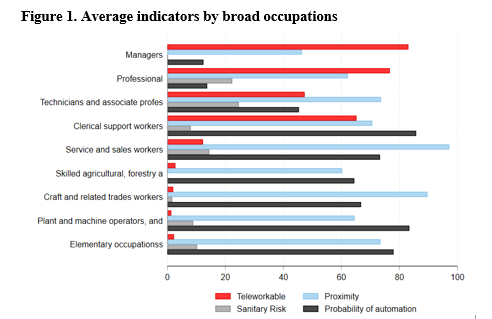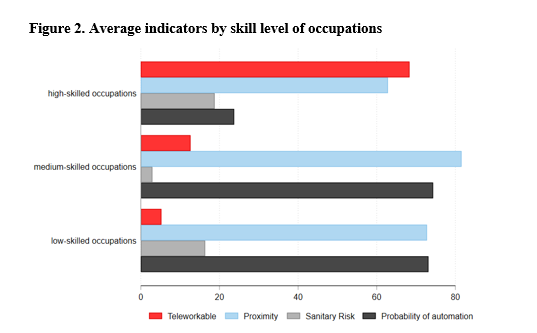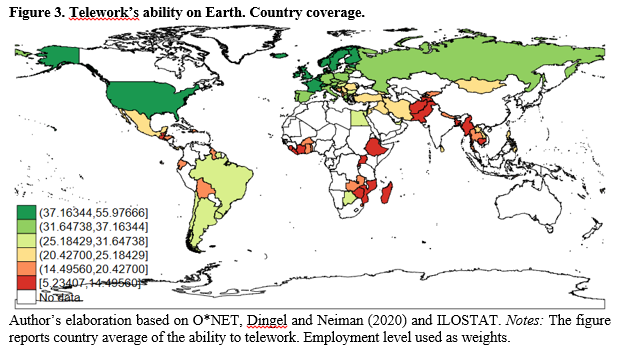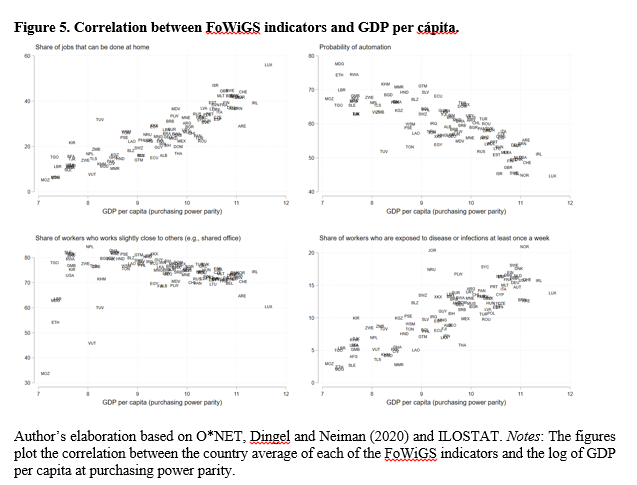We are releasing a blog series about risk administration strategies based on the conceptual framework developed by the Safely Back to Work Allianz (Randstad et al., 2020) that adapted the Occupational Risk Pyramid of the United States Occupational Safety and Health Administration (OSHA) to the COVID-19 context. In this scheme, potential measures are classified according to their ability to mitigate health risks and their economic impact, recognizing the tension that exists between these two dimensions.
The pyramid illustrates strategies for managing risk between two extremes. The peak represents the elimination of economic activity to eliminate the health risk of going to work. It is the most effective health strategy, but, at the same time, the one with the greatest economic impact, which makes it unsustainable over time. The pyramid’s base refers to the continuity of the usual production processes but introduces personal protection elements for workers. This last alternative is the one with the most negligible economic impact because it is the least disruptive, but it implies the maximum health risk of returning to work. Between these two segments there are intermediate alternatives such as substituting risks by working remotely (teleworking), implementing reengineering processes in workspaces to isolate people from risk, and introducing administrative controls to reduce the probability of contagion.
Our series addresses each of these risk administration strategies analyzing indicators from the new dataset developed by the Future of Work in the Global South (FoWiGS) initiative that comprises key variables related to health and economic risks for 108 countries at the occupational level and by gender, such as the ability to telework, the probability of automation, the sanitary risk at work, and the physical proximity at work. In this first series, we study how we can substitute risk through remote work and its implications in terms of inequality.
The COVID-19 pandemic constituted one of the biggest shocks to the labor market in history. Societies were forced to unlearn centuries of habits and practices regarding physical proximity at work, from face-to-face interactions in factories to coffee breaks at the office.
Thus, for the first time in many decades, the immediate impact of a shock to the labor market and its persistency over time was less related to a drop in demand and the speed of its recovery than on a complex, supply side, social reengineering process aimed at controlling health risks at work by creating low physical proximity environments.
Remote work became the main strategy to replace the health risk associated with high-physical proximity settings (offices, factories, buses) with a lower health risk arising from working from home. For a particular worker trying to secure an income, the ability to telework turned out to be crucial. How is this ability distributed across different occupations and countries? Is this distribution widening or narrowing inequality?
As shown in Figure 1, the ability to telework is heavily concentrated in occupations such as managers, professional, technicians, and clerks, while is almost negligible in jobs in agriculture, craft and machinery operators, and elementary occupations.

Source: Author’s elaboration based on O*NET, Dingel and Neiman (2020), and ILOSTAT. Notes: Teleworkable corresponds to the potential to telework measured by Dingel and Neiman (2020). The figure reports the world average of the teleworking indicator by 1 digit occupation of ISCO 08. Employment level used as weights.
A similar clear pattern arises based on the skill level of occupations, which suggests that those workers at greater risk due to the conditions imposed by the current crisis are also characterized by low-skilled-low-paying jobs (Goos et al., 2014).

Source: Author’s elaboration based on O*NET, Dingel and Neiman (2020), and ILOSTAT. Notes: Teleworkable corresponds to the potential to telework measured by Dingel and Neiman (2020). The figure reports the world average of the teleworking indicator by skill level of occupations according to Goos, Manning, and Salomons (2014) and Acemoglu and Autor (2011). Employment level used as weights.
And what about country comparison? The higher potential to telework is observed in high-income countries like EE.UU. and European economies. These are followed by countries in the Middle East and North Africa and Latin America and the Caribbean, where the average potential to telework is 26% and 23%, respectively. Meanwhile, countries in East and South Asia evidence a somewhat lower teleworks potential that ranges between 13% and 18% of total employment. Finally, those in Sub-Saharan Africa exhibit the lowest telework potential averaging 10% of total employment.

As shown in Figure 4, albeit women have borne a disproportionate share of employment losses in many countries, they tend to have a higher potential to telework than men. The world average potential to telework is 32% for women and 23% for men. However, there is substantial heterogeneity across broad-income country groups. The gap between women and men is larger in high and upper-middle-income countries, while it is almost nill in lower-middle and low-income economies. Finally, we find a clear positive cross-country correlation between the potential to telework and the GDP per capita (GDPpc), a usual proxy of economic development (Dingel and Neiman, 2020)

Source: Author’s elaboration. Notes: The figure shows box plots for the Telework’s ability by country income group and gender. The red boxes illustrate the 25th to the 75th percentile, the black line the median, and the whiskers are the values that are furthest away from the median on either side of the box, but are still within a distance of 1.5 times the interquartile range from the nearest quartile. The classification of countries by income group is taken from the World Development Indicators (World Bank).

In summary, the uneven distribution of the ability to telework across occupations, skill levels, gender, and GDP per capita levels points to an asymmetrical impact and recovery speed of labor markets from the COVID19 shock. Inequality in the world of work, thus, is likely to increase due to the pandemic.
These and more data can be founded in the new FoWiGS dataset, that lying at the intersection of technological change and health data provides insights into the new challenges faced by labor markets worldwide in the current pandemic scenario.
Acemoglu, D. and D. Autor (2011), Skills, tasks and technologies: Implications for employment and earnings, http://dx.doi.org/10.1016/S0169-7218(11)02410-5.
Dingel, J. I. and Neiman, B., (2020). “How many jobs can be done at home?” Journal of Public Economics, Elsevier, vol. 189(C).
Goos, M., A. Manning and A. Salomons (2014), “Explaining Job Polarization: Routine-Biased Technological Change and Offshoring”, American Economic Review, Vol. 104/8, pp. 2509– 2526.
Randstad, The Adecco Group y ManpowerGroup (2020). Safely Back to Work Best Practice Protocols, (May 2020). Retrieved from https://www.randstad.com/s3fs-media/rscom/public/2020-05/Best-Practice-Health-and-Safety-Protocols.pdf
IDRC has launched FOWIGS—a research program that will help understand how these changes are affecting the lives of the most vulnerable and suggest pathways for an inclusive digital future. The challenges are large and the questions are complex. But we need to face them now more than ever. Stay connected. Learn how.